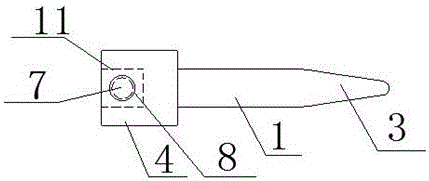Connecting prosthesis for bone defects
A prosthesis and backbone technology, applied in the medical field, can solve the problems of slow recovery function, delayed bone healing, pros and cons, etc., and achieve the effects of improving biocompatibility, reducing the weight of the prosthesis, and improving osteogenesis performance
- Summary
- Abstract
- Description
- Claims
- Application Information
AI Technical Summary
Problems solved by technology
Method used
Image
Examples
Embodiment Construction
[0026] Preferred embodiments of the present invention will be described in detail below in conjunction with the accompanying drawings.
[0027] figure 1 , figure 2 , image 3 , Figure 4 , Figure 5 and Figure 6 Show the specific embodiment of the present invention:
[0028] A connecting prosthesis for bone defects, comprising a fixed prosthesis 1 and an adjusting prosthesis 2, one end of the fixed prosthesis 1 is provided with a connecting part 4, and the other end is provided with a first medullary canal stem that can be inserted into the medullary canal 3. The first medullary canal handle 3 is integrally formed with the fixed prosthesis 1, and the structure is stable. The connecting part 4 is provided with a blind hole 11, and the blind hole 11 is provided with a first positioning hole 7. A positioning hole 7 is provided with a first locking screw 8, one end of the adjustment prosthesis 2 is arranged in the blind hole 11, and is detachably connected with the blind h...
PUM
 Login to View More
Login to View More Abstract
Description
Claims
Application Information
 Login to View More
Login to View More - R&D
- Intellectual Property
- Life Sciences
- Materials
- Tech Scout
- Unparalleled Data Quality
- Higher Quality Content
- 60% Fewer Hallucinations
Browse by: Latest US Patents, China's latest patents, Technical Efficacy Thesaurus, Application Domain, Technology Topic, Popular Technical Reports.
© 2025 PatSnap. All rights reserved.Legal|Privacy policy|Modern Slavery Act Transparency Statement|Sitemap|About US| Contact US: help@patsnap.com



